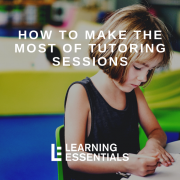LE Does It Best: How To Make the Most of Tutoring Time
As discussed in part I, the educators at Learning Essentials (LE) are fully committed to helping every learner achieve his or her goals. The adage, “It takes a village,” truly grounds our methods and mindset around education. We believe that, with the help of our “playbook,” students and families experience academic support through collaboration and communication. Below are just a few of the ways in which LE tutoring sessions incorporate best practices.
- Before learners are matched with a tutor, the executive director will conduct an intake meeting to assess the student’s learning style, preferences, strengths, and areas of need. This allows for the creation of a comprehensive learning plan, which will ensure that the best supports are put into place from the start.
- While we do not diagnose specific learning disabilities, our team is equipped to observe students’ learning profiles and connect families with the necessary professionals. We aim to ease the stress and confusion surrounding unique learning needs by providing academic tutoring, coaching, brain camps, parent workshops, and academic consulting.
- With collaboration from parents and any other necessary supports (teachers, pediatricians, behavior specialists, etc.) the team at Learning Essentials will develop learning goals and an academic “playbook” for the student. This playbook is a uniquely individualized approach to ensure that each learner receives customized instruction to work towards his or her personal best.
- Our advanced-degreed, highly qualified educators will work to provide learning support for any and all areas of need through one-to-one tutoring sessions. We address every aspect of a student’s educational needs, from medical needs and learning disabilities to psychological referrals and communication between the schools and families. It is always our goal to advocate for each learner and help him or her to simultaneously develop autonomy.
- Because communication is a best practice for student success, parents are not only part of the initial collaboration, but are also thoroughly kept in the loop after every tutoring session. LE tutors will submit detailed reports about the session goals, materials used, visible progress, and plans for next steps. With parent permission, tutors are also encouraged to communicate with the child’s teachers to ensure full support by adapting materials and differentiating instruction to meet the student’s unique needs.
- Unlike traditional tutoring services, LE tutors strive to not only address academic and study skills, but also to provide learners with methods for boosting motivation and develop an intrinsic desire for learning independently. We essentially aim to empower students by “training” them how to learn.
- Because the LE team is comprised of educational professionals, such as certified MCPS teachers, case managers, educational psychologists, language-based experts, experts in executive functioning, literacy coaches, and applied behavior therapists, we are able to fully support families with cutting-edge methods for instruction and research-based strategies to develop creativity, confidence, and positive study habits.
- As part of our approach for consistent communication, LE will not only work to help students reach their learning goals, but will also evaluate and discuss progress along the way. In measuring progress, tutors are able to modify and adapt instructional techniques and strategies as a best practice for learning. By individualizing each “playbook,” students’ needs are addressed in a personal but fluid fashion, allowing for flexibility and creative approaches to learning.





